International Finance Assignment: Concepts and Market Analysis
VerifiedAdded on 2023/01/17
|7
|1529
|80
Homework Assignment
AI Summary
This assignment solution comprehensively addresses several key concepts in international finance. It begins by comparing and contrasting the Law of One Price, absolute purchasing power parity (PPP), and relative PPP, explaining their implications and providing examples. The solution then evaluates the Fisher effect, detailing its relationship between nominal interest rates, real interest rates, and inflation, and proposing its theoretical and practical significance. A comparison between the Fisher effect and the international Fisher effect follows, highlighting the differences in their application to currency valuation. Finally, the assignment analyzes the 2001 foreign exchange turnover data, identifying significant exchange values, ranking them, and providing a breakdown of market activity by currency and geographic location, referencing the provided data from the Bank for International Settlements (BIS).
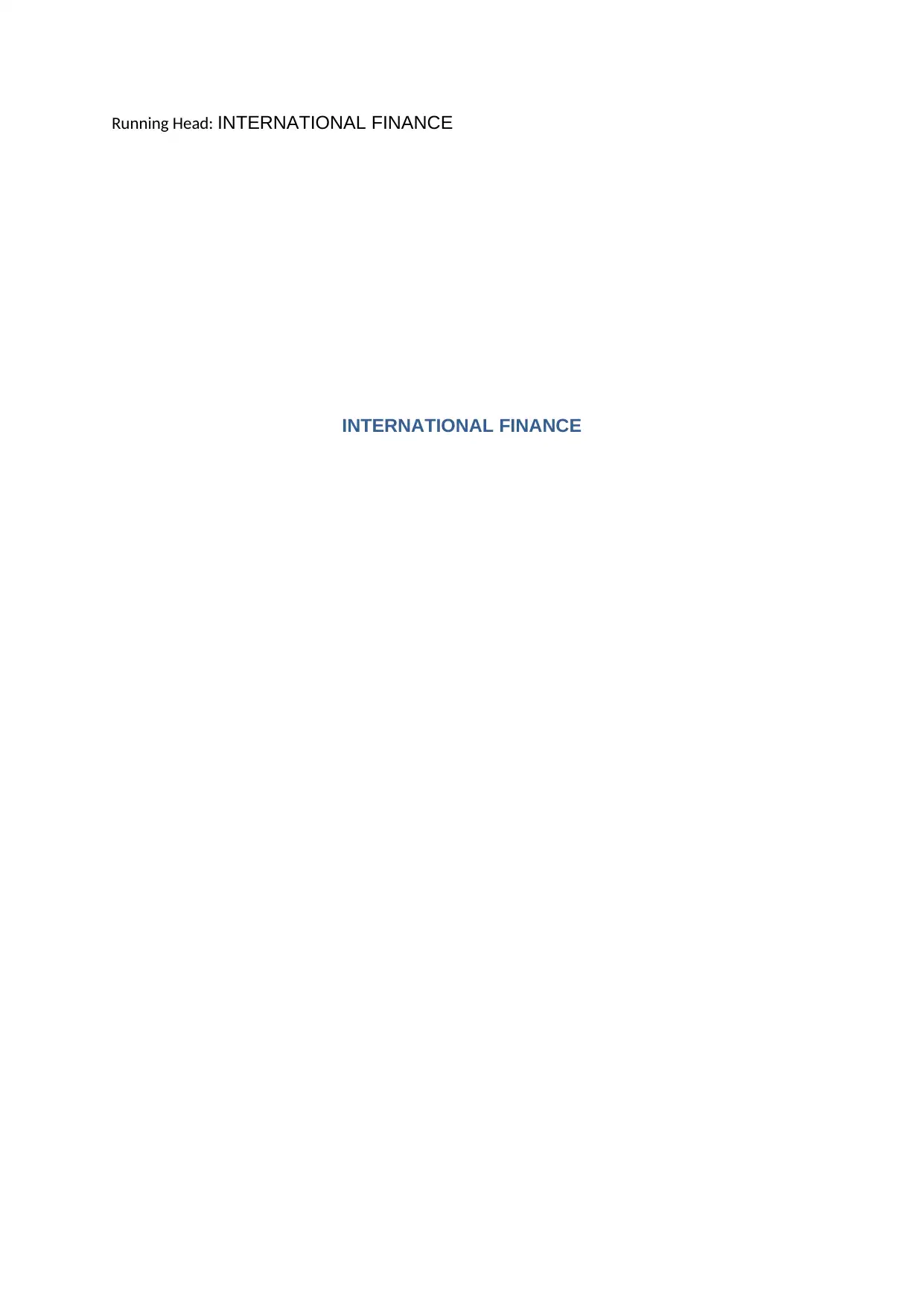
Running Head: INTERNATIONAL FINANCE
INTERNATIONAL FINANCE
INTERNATIONAL FINANCE
Paraphrase This Document
Need a fresh take? Get an instant paraphrase of this document with our AI Paraphraser
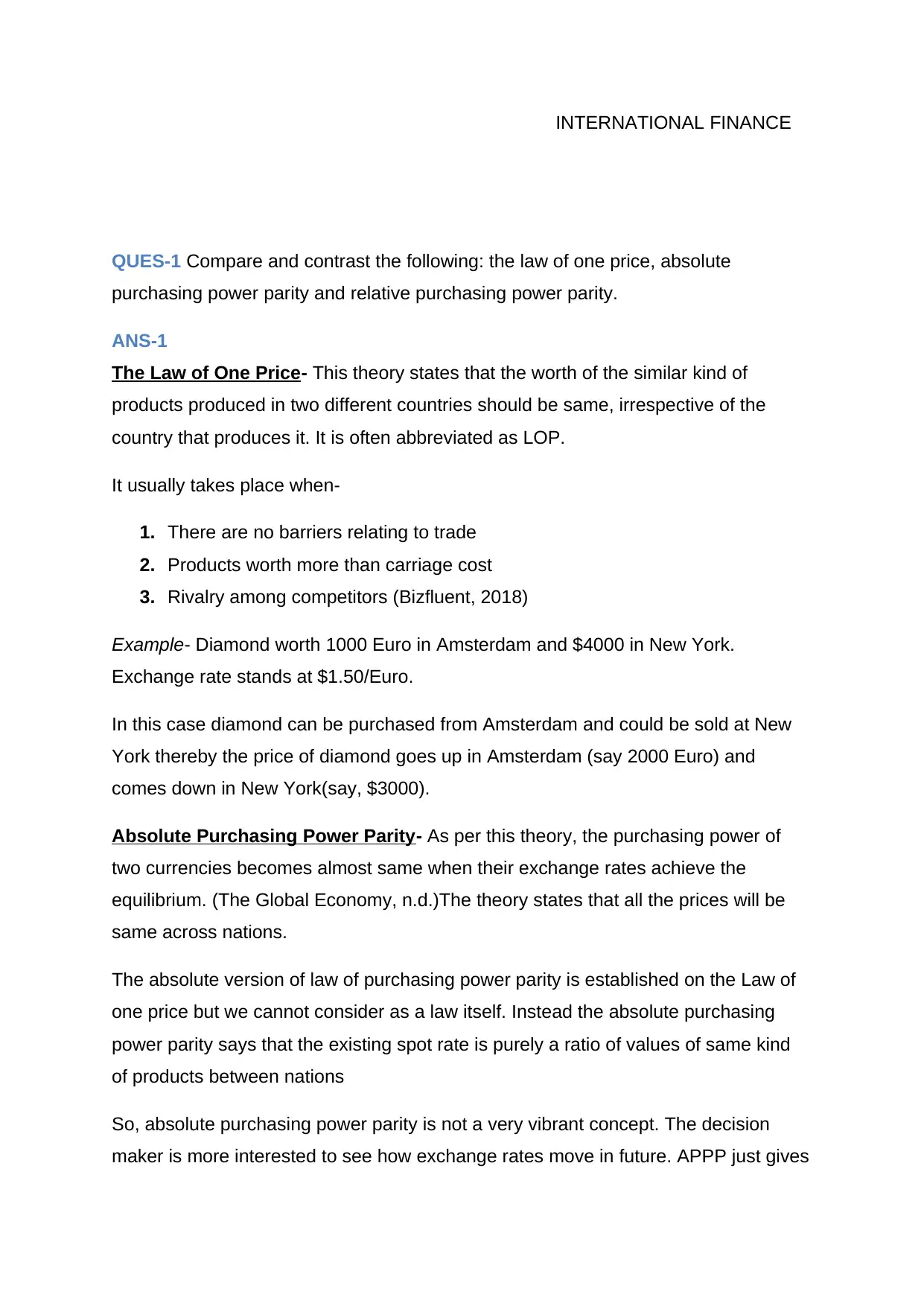
INTERNATIONAL FINANCE
QUES-1 Compare and contrast the following: the law of one price, absolute
purchasing power parity and relative purchasing power parity.
ANS-1
The Law of One Price- This theory states that the worth of the similar kind of
products produced in two different countries should be same, irrespective of the
country that produces it. It is often abbreviated as LOP.
It usually takes place when-
1. There are no barriers relating to trade
2. Products worth more than carriage cost
3. Rivalry among competitors (Bizfluent, 2018)
Example- Diamond worth 1000 Euro in Amsterdam and $4000 in New York.
Exchange rate stands at $1.50/Euro.
In this case diamond can be purchased from Amsterdam and could be sold at New
York thereby the price of diamond goes up in Amsterdam (say 2000 Euro) and
comes down in New York(say, $3000).
Absolute Purchasing Power Parity- As per this theory, the purchasing power of
two currencies becomes almost same when their exchange rates achieve the
equilibrium. (The Global Economy, n.d.)The theory states that all the prices will be
same across nations.
The absolute version of law of purchasing power parity is established on the Law of
one price but we cannot consider as a law itself. Instead the absolute purchasing
power parity says that the existing spot rate is purely a ratio of values of same kind
of products between nations
So, absolute purchasing power parity is not a very vibrant concept. The decision
maker is more interested to see how exchange rates move in future. APPP just gives
QUES-1 Compare and contrast the following: the law of one price, absolute
purchasing power parity and relative purchasing power parity.
ANS-1
The Law of One Price- This theory states that the worth of the similar kind of
products produced in two different countries should be same, irrespective of the
country that produces it. It is often abbreviated as LOP.
It usually takes place when-
1. There are no barriers relating to trade
2. Products worth more than carriage cost
3. Rivalry among competitors (Bizfluent, 2018)
Example- Diamond worth 1000 Euro in Amsterdam and $4000 in New York.
Exchange rate stands at $1.50/Euro.
In this case diamond can be purchased from Amsterdam and could be sold at New
York thereby the price of diamond goes up in Amsterdam (say 2000 Euro) and
comes down in New York(say, $3000).
Absolute Purchasing Power Parity- As per this theory, the purchasing power of
two currencies becomes almost same when their exchange rates achieve the
equilibrium. (The Global Economy, n.d.)The theory states that all the prices will be
same across nations.
The absolute version of law of purchasing power parity is established on the Law of
one price but we cannot consider as a law itself. Instead the absolute purchasing
power parity says that the existing spot rate is purely a ratio of values of same kind
of products between nations
So, absolute purchasing power parity is not a very vibrant concept. The decision
maker is more interested to see how exchange rates move in future. APPP just gives
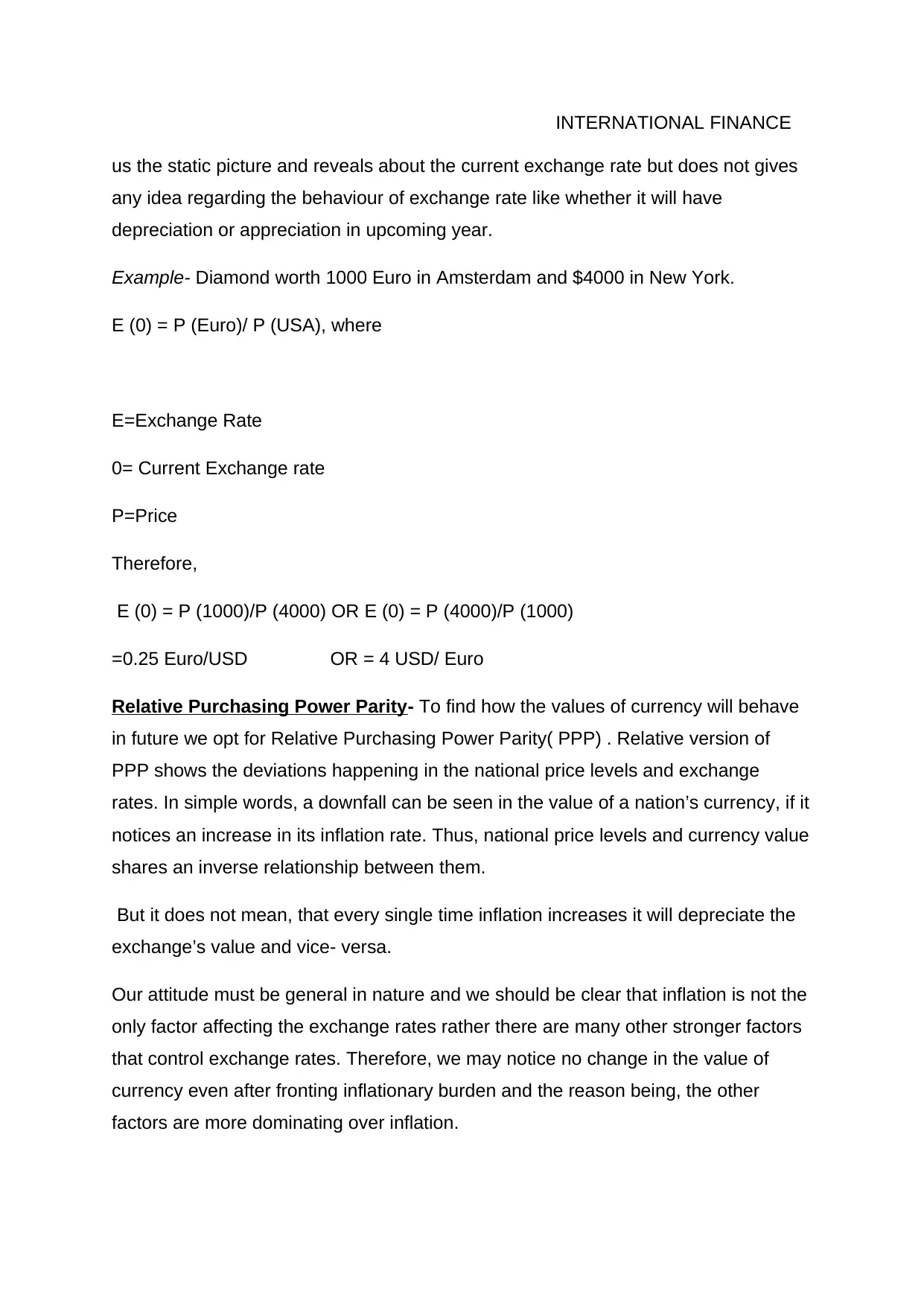
INTERNATIONAL FINANCE
us the static picture and reveals about the current exchange rate but does not gives
any idea regarding the behaviour of exchange rate like whether it will have
depreciation or appreciation in upcoming year.
Example- Diamond worth 1000 Euro in Amsterdam and $4000 in New York.
E (0) = P (Euro)/ P (USA), where
E=Exchange Rate
0= Current Exchange rate
P=Price
Therefore,
E (0) = P (1000)/P (4000) OR E (0) = P (4000)/P (1000)
=0.25 Euro/USD OR = 4 USD/ Euro
Relative Purchasing Power Parity- To find how the values of currency will behave
in future we opt for Relative Purchasing Power Parity( PPP) . Relative version of
PPP shows the deviations happening in the national price levels and exchange
rates. In simple words, a downfall can be seen in the value of a nation’s currency, if it
notices an increase in its inflation rate. Thus, national price levels and currency value
shares an inverse relationship between them.
But it does not mean, that every single time inflation increases it will depreciate the
exchange’s value and vice- versa.
Our attitude must be general in nature and we should be clear that inflation is not the
only factor affecting the exchange rates rather there are many other stronger factors
that control exchange rates. Therefore, we may notice no change in the value of
currency even after fronting inflationary burden and the reason being, the other
factors are more dominating over inflation.
us the static picture and reveals about the current exchange rate but does not gives
any idea regarding the behaviour of exchange rate like whether it will have
depreciation or appreciation in upcoming year.
Example- Diamond worth 1000 Euro in Amsterdam and $4000 in New York.
E (0) = P (Euro)/ P (USA), where
E=Exchange Rate
0= Current Exchange rate
P=Price
Therefore,
E (0) = P (1000)/P (4000) OR E (0) = P (4000)/P (1000)
=0.25 Euro/USD OR = 4 USD/ Euro
Relative Purchasing Power Parity- To find how the values of currency will behave
in future we opt for Relative Purchasing Power Parity( PPP) . Relative version of
PPP shows the deviations happening in the national price levels and exchange
rates. In simple words, a downfall can be seen in the value of a nation’s currency, if it
notices an increase in its inflation rate. Thus, national price levels and currency value
shares an inverse relationship between them.
But it does not mean, that every single time inflation increases it will depreciate the
exchange’s value and vice- versa.
Our attitude must be general in nature and we should be clear that inflation is not the
only factor affecting the exchange rates rather there are many other stronger factors
that control exchange rates. Therefore, we may notice no change in the value of
currency even after fronting inflationary burden and the reason being, the other
factors are more dominating over inflation.
⊘ This is a preview!⊘
Do you want full access?
Subscribe today to unlock all pages.

Trusted by 1+ million students worldwide
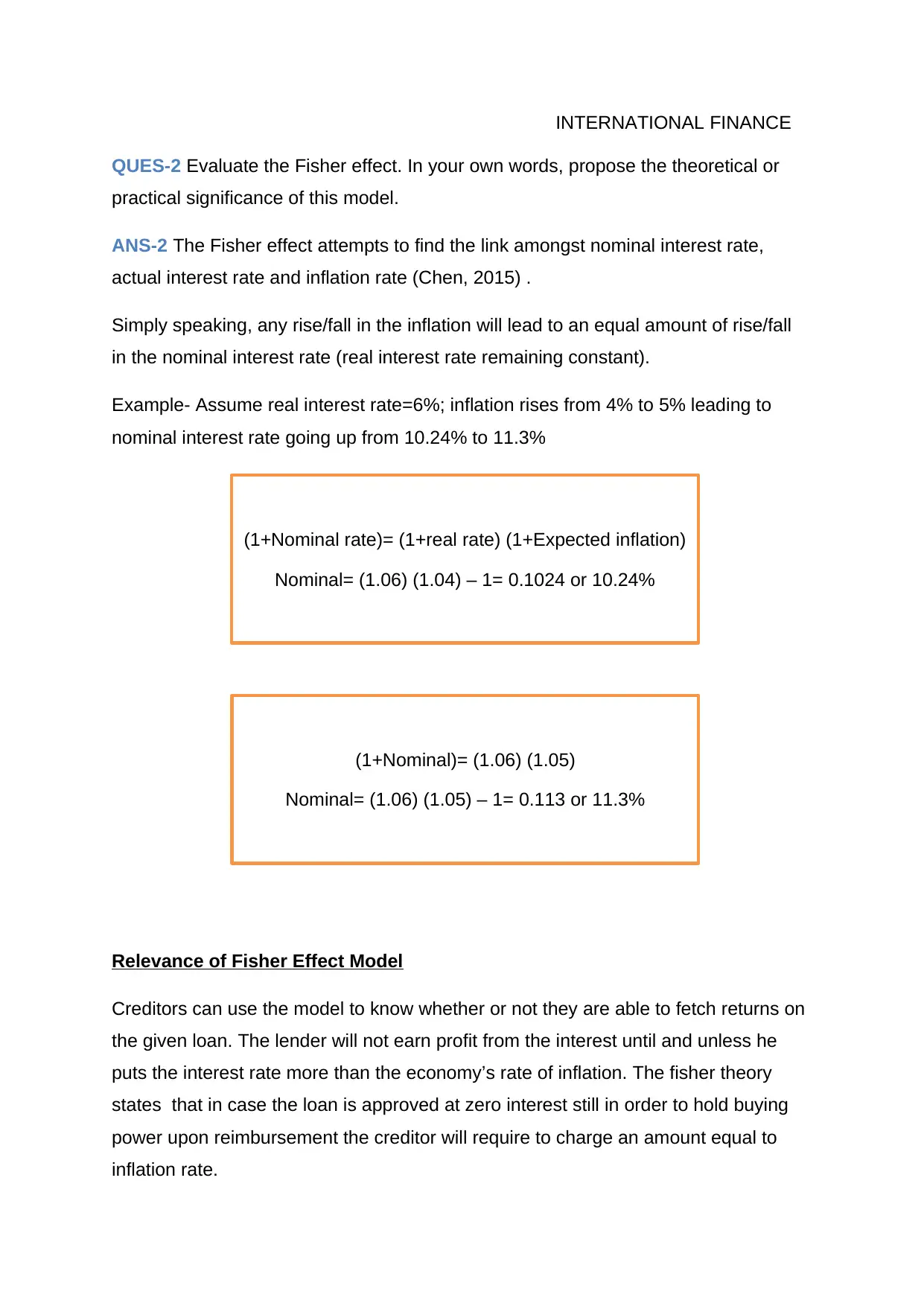
INTERNATIONAL FINANCE
QUES-2 Evaluate the Fisher effect. In your own words, propose the theoretical or
practical significance of this model.
ANS-2 The Fisher effect attempts to find the link amongst nominal interest rate,
actual interest rate and inflation rate (Chen, 2015) .
Simply speaking, any rise/fall in the inflation will lead to an equal amount of rise/fall
in the nominal interest rate (real interest rate remaining constant).
Example- Assume real interest rate=6%; inflation rises from 4% to 5% leading to
nominal interest rate going up from 10.24% to 11.3%
Relevance of Fisher Effect Model
Creditors can use the model to know whether or not they are able to fetch returns on
the given loan. The lender will not earn profit from the interest until and unless he
puts the interest rate more than the economy’s rate of inflation. The fisher theory
states that in case the loan is approved at zero interest still in order to hold buying
power upon reimbursement the creditor will require to charge an amount equal to
inflation rate.
(1+Nominal rate)= (1+real rate) (1+Expected inflation)
Nominal= (1.06) (1.04) – 1= 0.1024 or 10.24%
(1+Nominal)= (1.06) (1.05)
Nominal= (1.06) (1.05) – 1= 0.113 or 11.3%
QUES-2 Evaluate the Fisher effect. In your own words, propose the theoretical or
practical significance of this model.
ANS-2 The Fisher effect attempts to find the link amongst nominal interest rate,
actual interest rate and inflation rate (Chen, 2015) .
Simply speaking, any rise/fall in the inflation will lead to an equal amount of rise/fall
in the nominal interest rate (real interest rate remaining constant).
Example- Assume real interest rate=6%; inflation rises from 4% to 5% leading to
nominal interest rate going up from 10.24% to 11.3%
Relevance of Fisher Effect Model
Creditors can use the model to know whether or not they are able to fetch returns on
the given loan. The lender will not earn profit from the interest until and unless he
puts the interest rate more than the economy’s rate of inflation. The fisher theory
states that in case the loan is approved at zero interest still in order to hold buying
power upon reimbursement the creditor will require to charge an amount equal to
inflation rate.
(1+Nominal rate)= (1+real rate) (1+Expected inflation)
Nominal= (1.06) (1.04) – 1= 0.1024 or 10.24%
(1+Nominal)= (1.06) (1.05)
Nominal= (1.06) (1.05) – 1= 0.113 or 11.3%
Paraphrase This Document
Need a fresh take? Get an instant paraphrase of this document with our AI Paraphraser
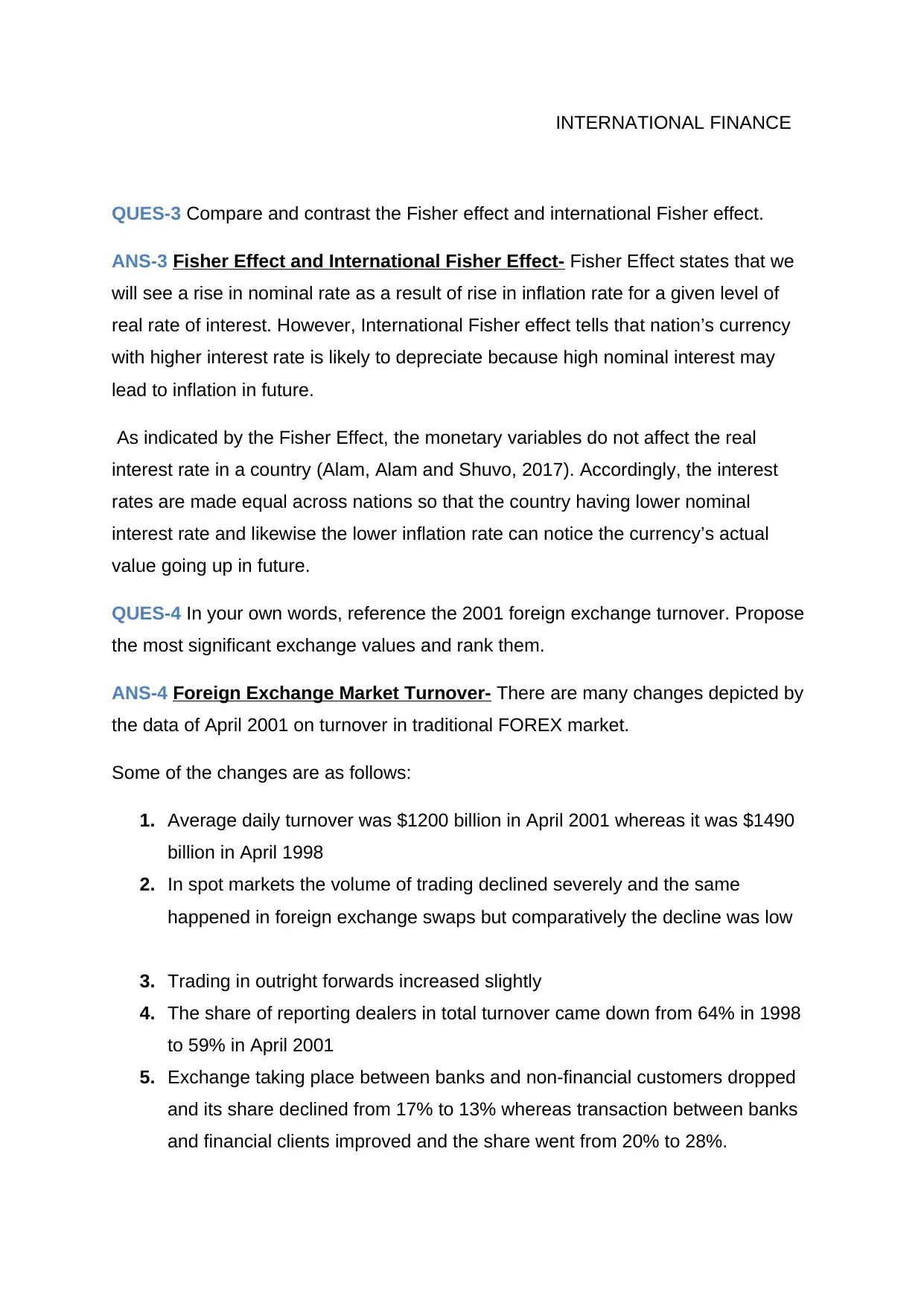
INTERNATIONAL FINANCE
QUES-3 Compare and contrast the Fisher effect and international Fisher effect.
ANS-3 Fisher Effect and International Fisher Effect- Fisher Effect states that we
will see a rise in nominal rate as a result of rise in inflation rate for a given level of
real rate of interest. However, International Fisher effect tells that nation’s currency
with higher interest rate is likely to depreciate because high nominal interest may
lead to inflation in future.
As indicated by the Fisher Effect, the monetary variables do not affect the real
interest rate in a country (Alam, Alam and Shuvo, 2017). Accordingly, the interest
rates are made equal across nations so that the country having lower nominal
interest rate and likewise the lower inflation rate can notice the currency’s actual
value going up in future.
QUES-4 In your own words, reference the 2001 foreign exchange turnover. Propose
the most significant exchange values and rank them.
ANS-4 Foreign Exchange Market Turnover- There are many changes depicted by
the data of April 2001 on turnover in traditional FOREX market.
Some of the changes are as follows:
1. Average daily turnover was $1200 billion in April 2001 whereas it was $1490
billion in April 1998
2. In spot markets the volume of trading declined severely and the same
happened in foreign exchange swaps but comparatively the decline was low
3. Trading in outright forwards increased slightly
4. The share of reporting dealers in total turnover came down from 64% in 1998
to 59% in April 2001
5. Exchange taking place between banks and non-financial customers dropped
and its share declined from 17% to 13% whereas transaction between banks
and financial clients improved and the share went from 20% to 28%.
QUES-3 Compare and contrast the Fisher effect and international Fisher effect.
ANS-3 Fisher Effect and International Fisher Effect- Fisher Effect states that we
will see a rise in nominal rate as a result of rise in inflation rate for a given level of
real rate of interest. However, International Fisher effect tells that nation’s currency
with higher interest rate is likely to depreciate because high nominal interest may
lead to inflation in future.
As indicated by the Fisher Effect, the monetary variables do not affect the real
interest rate in a country (Alam, Alam and Shuvo, 2017). Accordingly, the interest
rates are made equal across nations so that the country having lower nominal
interest rate and likewise the lower inflation rate can notice the currency’s actual
value going up in future.
QUES-4 In your own words, reference the 2001 foreign exchange turnover. Propose
the most significant exchange values and rank them.
ANS-4 Foreign Exchange Market Turnover- There are many changes depicted by
the data of April 2001 on turnover in traditional FOREX market.
Some of the changes are as follows:
1. Average daily turnover was $1200 billion in April 2001 whereas it was $1490
billion in April 1998
2. In spot markets the volume of trading declined severely and the same
happened in foreign exchange swaps but comparatively the decline was low
3. Trading in outright forwards increased slightly
4. The share of reporting dealers in total turnover came down from 64% in 1998
to 59% in April 2001
5. Exchange taking place between banks and non-financial customers dropped
and its share declined from 17% to 13% whereas transaction between banks
and financial clients improved and the share went from 20% to 28%.
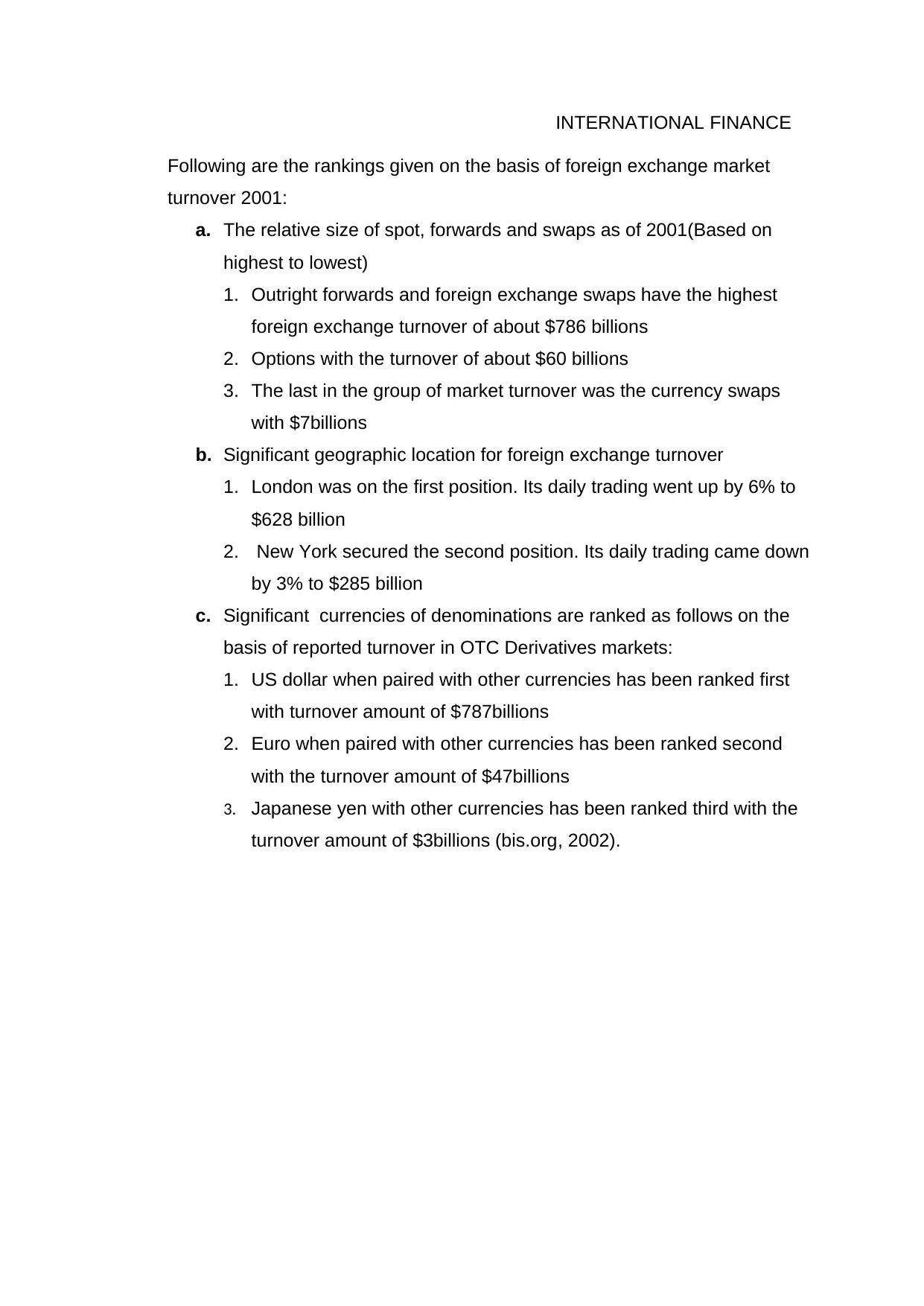
INTERNATIONAL FINANCE
Following are the rankings given on the basis of foreign exchange market
turnover 2001:
a. The relative size of spot, forwards and swaps as of 2001(Based on
highest to lowest)
1. Outright forwards and foreign exchange swaps have the highest
foreign exchange turnover of about $786 billions
2. Options with the turnover of about $60 billions
3. The last in the group of market turnover was the currency swaps
with $7billions
b. Significant geographic location for foreign exchange turnover
1. London was on the first position. Its daily trading went up by 6% to
$628 billion
2. New York secured the second position. Its daily trading came down
by 3% to $285 billion
c. Significant currencies of denominations are ranked as follows on the
basis of reported turnover in OTC Derivatives markets:
1. US dollar when paired with other currencies has been ranked first
with turnover amount of $787billions
2. Euro when paired with other currencies has been ranked second
with the turnover amount of $47billions
3. Japanese yen with other currencies has been ranked third with the
turnover amount of $3billions (bis.org, 2002).
Following are the rankings given on the basis of foreign exchange market
turnover 2001:
a. The relative size of spot, forwards and swaps as of 2001(Based on
highest to lowest)
1. Outright forwards and foreign exchange swaps have the highest
foreign exchange turnover of about $786 billions
2. Options with the turnover of about $60 billions
3. The last in the group of market turnover was the currency swaps
with $7billions
b. Significant geographic location for foreign exchange turnover
1. London was on the first position. Its daily trading went up by 6% to
$628 billion
2. New York secured the second position. Its daily trading came down
by 3% to $285 billion
c. Significant currencies of denominations are ranked as follows on the
basis of reported turnover in OTC Derivatives markets:
1. US dollar when paired with other currencies has been ranked first
with turnover amount of $787billions
2. Euro when paired with other currencies has been ranked second
with the turnover amount of $47billions
3. Japanese yen with other currencies has been ranked third with the
turnover amount of $3billions (bis.org, 2002).
⊘ This is a preview!⊘
Do you want full access?
Subscribe today to unlock all pages.

Trusted by 1+ million students worldwide
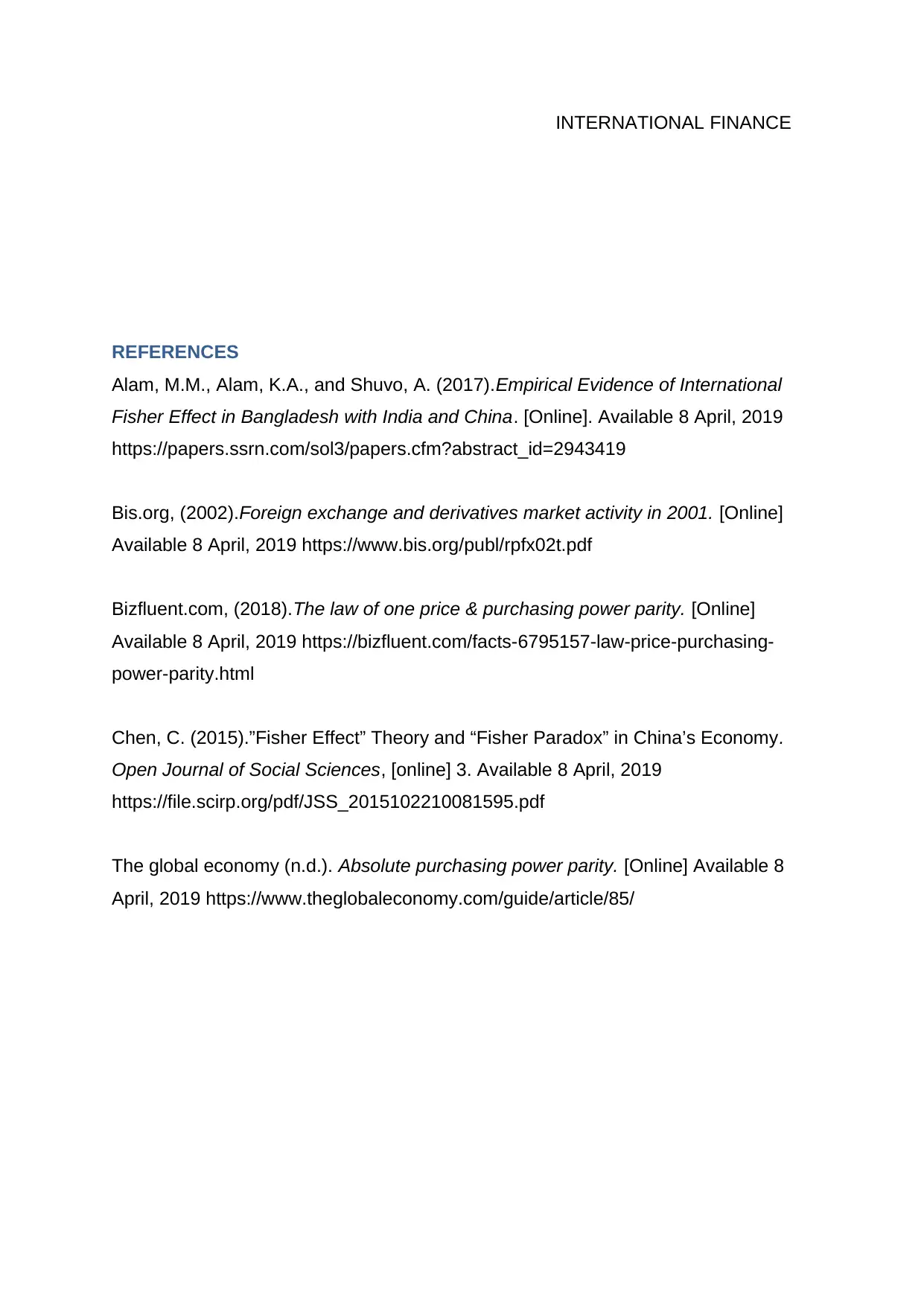
INTERNATIONAL FINANCE
REFERENCES
Alam, M.M., Alam, K.A., and Shuvo, A. (2017).Empirical Evidence of International
Fisher Effect in Bangladesh with India and China. [Online]. Available 8 April, 2019
https://papers.ssrn.com/sol3/papers.cfm?abstract_id=2943419
Bis.org, (2002).Foreign exchange and derivatives market activity in 2001. [Online]
Available 8 April, 2019 https://www.bis.org/publ/rpfx02t.pdf
Bizfluent.com, (2018).The law of one price & purchasing power parity. [Online]
Available 8 April, 2019 https://bizfluent.com/facts-6795157-law-price-purchasing-
power-parity.html
Chen, C. (2015).”Fisher Effect” Theory and “Fisher Paradox” in China’s Economy.
Open Journal of Social Sciences, [online] 3. Available 8 April, 2019
https://file.scirp.org/pdf/JSS_2015102210081595.pdf
The global economy (n.d.). Absolute purchasing power parity. [Online] Available 8
April, 2019 https://www.theglobaleconomy.com/guide/article/85/
REFERENCES
Alam, M.M., Alam, K.A., and Shuvo, A. (2017).Empirical Evidence of International
Fisher Effect in Bangladesh with India and China. [Online]. Available 8 April, 2019
https://papers.ssrn.com/sol3/papers.cfm?abstract_id=2943419
Bis.org, (2002).Foreign exchange and derivatives market activity in 2001. [Online]
Available 8 April, 2019 https://www.bis.org/publ/rpfx02t.pdf
Bizfluent.com, (2018).The law of one price & purchasing power parity. [Online]
Available 8 April, 2019 https://bizfluent.com/facts-6795157-law-price-purchasing-
power-parity.html
Chen, C. (2015).”Fisher Effect” Theory and “Fisher Paradox” in China’s Economy.
Open Journal of Social Sciences, [online] 3. Available 8 April, 2019
https://file.scirp.org/pdf/JSS_2015102210081595.pdf
The global economy (n.d.). Absolute purchasing power parity. [Online] Available 8
April, 2019 https://www.theglobaleconomy.com/guide/article/85/
1 out of 7
Related Documents
Your All-in-One AI-Powered Toolkit for Academic Success.
+13062052269
info@desklib.com
Available 24*7 on WhatsApp / Email
![[object Object]](/_next/static/media/star-bottom.7253800d.svg)
Unlock your academic potential
Copyright © 2020–2025 A2Z Services. All Rights Reserved. Developed and managed by ZUCOL.





